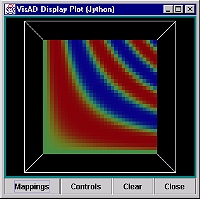
In each of these, you supply an array (or Jython "list") of floating point values - either one or two dimesional. In the signatures that allow you to specify a name, the String you specify becomes the name of the range component of your data; the default is simply "value". This name may not contain spaces!
The domain is by default a simple one- or two-dimensional sampling from 0 to the number of items in the values array. In the one-dimensional case, the name associated with this is "domain"; in the 2-D case the components are called "ImageLine" and "ImageElement". You will find several methods that make it convenient and easy to define this domain (see, for example, makeDomain()...whereever it is).
from visad.python.JPythonMethods import *
import math
z = []
for i in range(0,32):
a = []
for j in range(0,32):
a.append( math.sin(i*j*.0174533))
z.append(a)
f = field(z)
plot(f)
Produces this display:
